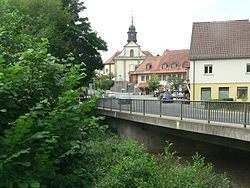Admin. region Unterfranken Elevation 180 m (590 ft) Area 35.92 km² Local time Thursday 6:16 PM Dialling code 06029 | District Aschaffenburg Time zone CET/CEST (UTC+1/+2) Population 12,208 (31 Dec 2008) Postal code 63776 | |
 | ||
Weather 12°C, Wind E at 13 km/h, 71% Humidity | ||
Mömbris is a community – since 31 January 1964 a market community – in the Aschaffenburg district in the Regierungsbezirk of Lower Franconia (Unterfranken) in Bavaria, Germany. Mömbris is the district’s fifth biggest community.
Contents
- Map of MC3B6mbris Germany
- Location
- Constituent communities
- Amalgamations
- Bavaria Hesse boundary
- History
- Mayors
- Community council
- Town twinning
- Coat of arms
- Economy
- Sports
- Education
- Honorary citizens
- Sons and daughters of the town
- Others linked to the community
- References
Map of M%C3%B6mbris, Germany
Location
Mömbris lies in the Bavarian Lower Main (Bayerischer Untermain) in the Kahlgrund halfway between Schöllkrippen and Alzenau, which are linked by Staatsstraße (State Road) 2305, at the foot of the Vorspessart (range) with its highest elevation, the Hahnenkamm at 437 m above sea level. The river Kahl flows through Mömbris.
Mömbris comprises all together 18 centres in an area of 35.92 km². The greater share (32.81 km²) is woods, meadows and cropland. The community lies between 165 and 337 m above sea level.
Constituent communities
Mömbris’s Ortsteile are as follows:
Amalgamations
Bavaria-Hesse boundary
Hesse pokes a tongue of its territory into the market community. In 2007, a territorial exchange involving roughly 10 hectares of land was undertaken between Hesse and Bavaria, whereby the latter shrank by 1.77 hectares.
Until this time, the state boundary ran right through the FV Viktoria 1930 e. V. Brücken (football club) clubhouse. Elsewhere, the boundary also cut through a short stretch of Staatsstraße 2305 – a road administered by Bavaria – in the outlying centre of Niedersteinbach, meaning that this Bavarian-owned road ran for a short distance through Hesse; this stretch of road came to be known as the Hessenkurve.
History
The Mömbris tithe court belonged until 1748, along with those of Alzenau and Hörstein and the free court to the Wilmundsheim vor der Hart (Alzenau) Markgenossenschaft (a kind of collective arrangement in which several villages jointly owned land resources). Free Märker (Markgenossenschaft dwellers) gathered every year in Alzenau to choose a Landrichter (judge) and foresters and to deal with important decisions.
The tithe courts originally had Imperial immediacy. Chairmanship was held by a tithe count chosen to serve for one year. Each village supplied, commensurately with each one’s number of freemen, Schöffen (roughly “lay jurists”) whose job it was to mete out justice. In 1500, the tithe courts lost their Imperial immediacy along with its attendant privileges. Ecclesiastical jurisdiction was thereafter exercised by the Archbishopric of Mainz.
Mömbris became under the Reichsdeputationshauptschluss in 1803 part of the newly formed Principality of Aschaffenburg, ruled by Prince primate Karl Theodor von Dalberg, with which it passed in 1814 (by this time it had become a department of the Grand Duchy of Frankfurt) to Bavaria.
Mayors
Community council
The council is made up of 25 council members, counting the full-time mayor.
(as at municipal election held on 2 March 2008)
Town twinning
Coat of arms
The community’s arms might be described thus: Gules a sword argent palewise the hilt and pommel Or, dexter a wheel of the second spoked of six, sinister a crown proper with four leaves.
Mömbris was until 1500 a kingly estate, as witnessed by the crown on the sinister (armsbearer’s left, viewer’s right) side. The place was also the seat of a free court, symbolized by the sword. In 1487, Electoral Mainz managed to acquire a share of sovereignty over the area, and in 1738, this became total. The six-spoked wheel (Wheel of Mainz) on the dexter (armsbearer’s right, viewer’s left) side recalls this.
In 1963, Mömbris was granted market rights.
The arms were designed and introduced in 1961.
Economy
The high population figure belies Mömbris’s scattered, agricultural character, for since the sweeping municipal reform in the late 1970s, Mömbris has been made up of 18 constituent communities. These are mainly small centres with 200 to 1,000 inhabitants, the exceptions being Schimborn (1,800) and the namesake centre Mömbris (2,000), giving the market community of Mömbris a population of some 12,000 in 2004. Over the last few years, Mömbris has had to deal with a fall in population and economic problems (loss of buying power in the neighbouring Kahlgrund towns of Schöllkrippen and Alzenau). Mömbris has repeatedly been Bavaria’s most indebted municipality in proportion to its population.
According to official statistics, there were 1,038 workers on the social welfare contribution rolls working in agriculture, forestry and producing businesses in 1998. In trade and transport this was 410. In other areas, 398 workers on the social welfare contribution rolls were employed, and 4,435 such workers worked from home. There were 3 processing businesses. Twenty-nine businesses were in construction, and furthermore, in 1999, there were 117 agricultural operations with a working area of 1 240 ha, of which 592 ha was cropland and 613 ha was meadowland.
Sports
Mömbris is home to the Bundesliga wrestling team RWG Mömbris-Königshofen.
Education
In 1999, the following institutions were to be found in Mömbris:
